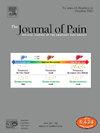神经病理性疼痛试验中基于每日与单周回忆的疼痛质量评估的平均值:对检测灵敏度的影响。
IF 4
2区 医学
Q1 CLINICAL NEUROLOGY
引用次数: 0
摘要
神经病理性疼痛患者常常表现出不同的疼痛和非疼痛感觉,这些感觉可作为随机临床试验(RCT)的结果。本研究旨在调查这些感觉质量的严重程度在参与者内部的变异性,以及 7 次每日疼痛质量评估的平均值是否比基于单周回忆的评估提供更好的检测灵敏度(即对治疗效果更敏感)。这项二次分析使用了一项经皮神经电刺激治疗化疗引起的周围神经病变的 RCT 数据(N=142)。参与者在试验基线和终点(治疗 6 周后)使用 0-10 数字评分量表对疼痛和非疼痛感觉质量的严重程度进行评分,每天评分 1 周(24 小时回忆),每周结束时评分 1 次(一周回忆)。在疼痛质量检测敏感性分析中,这 2 种测量方法用于:(1)确定研究样本(即有多少参与者达到最低基线疼痛质量严重程度);(2)使用方差分析计算观察到的效应大小(即组间平均疼痛质量差异)。预计在未来的临床试验中检测热痛/灼痛和抽筋的观察效应大小所需的样本量,采用日平均结果比采用周回忆结果要小得多(即热痛/灼痛:153 人对 388 人;抽筋:121 人对 349 人),而采用日平均结果的尖锐痛/枪刺痛(22 人)的样本量仅略大于日平均结果。与基于单周回忆的疼痛质量评估相比,每日评估的平均值在用于定义入选标准和评估结果时,可能会提高 RCT 检测的灵敏度。展望:这项研究表明,在临床试验中用于确定入选标准和评估结果时,每日疼痛质量评估的平均值可提高检测灵敏度。这项工作可为未来评估不同疼痛质量强度的临床试验设计提供参考。数据提供:支持本研究结果的数据和程序代码可向签署数据使用协议的通讯作者索取。本文章由计算机程序翻译,如有差异,请以英文原文为准。
Mean of Daily Versus Single Week Recall-Based Pain Quality Assessments in Neuropathic Pain Trials: Implications for Assay Sensitivity
Patients with neuropathic pain often present with variable pain and nonpainful sensory qualities that could serve as outcomes in randomized clinical trials (RCTs). This study aimed to investigate the within-participant variability in the severity of these sensory qualities and whether the means of 7 daily pain quality assessments provide better assay sensitivity (ie, more sensitivity to treatment effects) than single-week recall-based assessments. This secondary analysis used data from an RCT of transcutaneous electrical nerve stimulation for chemotherapy-induced peripheral neuropathy (N = 142). Participants rated the severity of painful and nonpainful sensory qualities using 0 to 10 numeric rating scales daily for 1 week (24-hour recall) and 1 time at the end of each week (week recall) at trial baseline and endpoint (after 6 weeks of treatment). For pain quality assay sensitivity analyses, the 2 types of measures were used to 1) define the study sample (ie, how many participants met minimum baseline pain quality severity) and 2) calculate the observed effect sizes (ie, between-group differences in mean pain qualities) using analysis of covariances. The projected sample sizes required to detect the observed effect sizes in future clinical trials for hot/burning pain and cramping were substantially smaller using the daily mean outcome compared with week recall (ie, hot/burning pain: 153 vs 388, cramping: 121 vs 349), and only marginally larger for sharp/shooting pain (22 participants) with the daily mean outcome. Compared with single-week recall-based assessments of pain qualities, the mean of daily assessments may improve RCT assay sensitivity when used to define entry criteria and assess outcomes.
Perspective
This study suggests that means of daily pain quality assessments may improve assay sensitivity when used to define entry criteria and assess outcomes in clinical trials. This work may inform design of future clinical trials evaluating the intensity of different pain qualities.
求助全文
通过发布文献求助,成功后即可免费获取论文全文。
去求助
来源期刊

Journal of Pain
医学-临床神经学
CiteScore
6.30
自引率
7.50%
发文量
441
审稿时长
42 days
期刊介绍:
The Journal of Pain publishes original articles related to all aspects of pain, including clinical and basic research, patient care, education, and health policy. Articles selected for publication in the Journal are most commonly reports of original clinical research or reports of original basic research. In addition, invited critical reviews, including meta analyses of drugs for pain management, invited commentaries on reviews, and exceptional case studies are published in the Journal. The mission of the Journal is to improve the care of patients in pain by providing a forum for clinical researchers, basic scientists, clinicians, and other health professionals to publish original research.
 求助内容:
求助内容: 应助结果提醒方式:
应助结果提醒方式:


